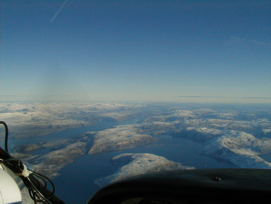
Across the pond the long way round
Flying a small, twin engined, non de-iced aeroplane across the Pond to UK in October is not a venture that one takes lightly. I had purchased my Beech Duchess in January when I had been expecting longer in Huntsville, Alabama but I was now to return to UK prematurely. I had resolved the issue of aircraft VAT liability with Customs and Excise, so in early October, I committed to the project. I also wanted to get the aircraft back before the winter settled in the far north of Canada and Greenland. I had also arranged for the aircraft to repainted and serviced so that she was ready for the ferry trip.
At the last moment, things seemed to fall into place; I had charts, airfield approach plates, immersion suit and a military aircrew lifejacket, complete with ELT. Getting my old liferaft to the US from UK as non-hazardous air cargo was an issue, finally resolved by me carefully discharging the gas cylinder in my garage in UK and then Fedexing the raft to a servicing agent in Florida. It was fully serviced there and forwarded to my departure airfield in lower Alabama, arriving on the day of my departure. I also updated all the on board GPS data bases for international fields and bought a handheld Garmin GPS for navigation redundancy.
On 8 Oct, in the comfort of British Airways at 35,000’ en route to Atlanta from London, I was pouring over charts, flight planning my return trip at low level (< 12,000’) via Northern Canada, Greenland, Iceland and Scotland. Although I had flown in the USA extensively when working there and had flown the Atlantic before in a King Air, this flight would be a greater challenge. The route north of Quebec to Iceland, I considered to be the most formidable, with icing hazard being the greatest factor. I knew there were excellent weather forecast flight briefing facilities in Bangor Maine, Quebec City, Sondestrom Greenland and Reykjavik that I could later rely on; I would later discover just how outstanding their service is.
The route I would take would be the conventional northern route used by general aviation ferry flights with limited endurance. Because it stretches into the Northern Reaches of Baffin Island and Greenland, it is normally flown in the summer for safety reasons but high pressure weather systems in the winter months often offers beautiful VMC flying conditions. I had considered installing a fuel ferry tank that would give me extra range and a warmer, more southerly route but the FAA require 30 days to process the modification which I did not have. My endurance was limited to 5 hours at 160 kts, so points of no return and diversion airfields would have to be carefully monitored. The route would take me from lower Alabama, through Bangor, Maine USA to Baffin Island (Iqaluit) in Canada, Greenland, Iceland, Scotland, Northern Ireland and finally my final destination at Yeovilton.
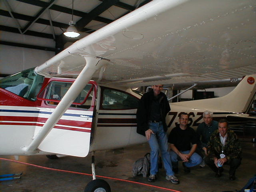
Departing Huntsville for Wetumpka by C182 RG
Friday 10 Oct
During my time in Huntsville, I had given flight instruction at Redstone Flying Club. I had asked their chief aircraft engineer to prepare the aircraft for the flight; he had also visited it in the previous month at Wetumpka in lower Alabama to ensure that the paint job was up to specification and he had also refitted all the control surfaces.
I would be starting the flight from Wetumpka and I was anxious to get going, so on a very grim and overcast morning we set off at 8 am in a Cessna 182RG. This one hour flight took us close to Montgomery, Alabama and it gave me an opportunity to check my new handheld Garmin. It seemed to perform flawlessly from the outset which was a great relief. Out of interest, I input my final destination RNAS Yeovilton (EGDY) and it indicated 3600 nm!! This great circle distance is also considerably shorter than the route I would be taking.
On landing at Wetumpka, I saw the Duchess for the first time since respray. She had been repainted in similar colours but she looked absolutely immaculate. Closer inspection revealed a pretty thorough job, so I was happy. The weather closed in quickly and Robert completed some lighting repairs in the pouring rain. I carefully checked the aeroplane and everything seemed in order; Robert and I checked the engines together and even the temperamental but essential cabin heater seemed to be behave.
At 1.20pm, I took off in minimum IFR conditions and heavy rain for Cumberland, Maryland some 520 nm away. I punched out of cloud at about 3000’ between layers and was given a direct routing by Atlanta ATC; I could just imagine getting the same routing through London. The airplane quickly settled down showing she had been well prepared for the trip. I had had multi-grade oil put in the engines to cope with temperatures that can get as low as -20 celsius up North. However, the right alternator low voltage light remained on despite the gauge showing normal reading. Since the stormscope read the output voltage correctly, I decided it was an indication problem and forged on. The 4 hour flight continued uneventfully, giving me ample opportunity for contemplating the more challenging legs ahead and my need for a pee at some stage; for which I carried a bottle for such emergencies! Cumberland airfield is typical of the airfields one finds throughout the USA – very long runway, precision approaches, fuel less than $2.75 per gallon, pilot activated lighting, no ATC and best of all, no landing fees. The Fixed Base Operator (FBO) found me a comfortable hotel which collected me from the airport. Day one completed successfully!
Saturday 11 Oct
I expected this to be a routine day, routing through customs at Bangor, Maine and then on to Sept Isles in Canada for the night. As expected, the trip up to Bangor was uneventful except for an usual 30kt headwind caused by a low pressure system off New York. I always find it interesting to note the different air traffic controller accents and attitudes on flying through the USA’s eastern seaboard. The Southerners seem to have time to chat but when you are controlled by New York ATC, you had better be on your toes or you might even be sworn at! That said, they can be unusually obliging and the New York controller even wished me a good weekend on this occasion; I suspect he knew I was on my way over to the UK since Bangor, Maine is a popular general aviation route into and out of the USA. I touched down at 1pm on this 4 hour flight; I was pleased to have made good progress since leaving Alabama despite the headwind. Bangor has a very friendly FBO and they helpfully provided fuel and advice; even taking me to see customs and clear the aircraft for export. I called Canadian customs then to advise them of my intention to fly to Sept Isle to be told that this was not possible at the weekend without prior notification. My first hiccup, but the Canadian customs advised that Quebec City could accept me and this would only be a slight detour. I re-filed my flight plan for Quebec City and was airborne within 30 minutes. The weather was beautiful and I got my first views of the barren North on this 1 hour flight. The Canadian controller cleared me for a more convenient runway and with 2 miles to run I realised I was on a collision course with a flock of Canadian geese on the reciprocal heading. A 90 degree detour and major manipulation of the aircraft got me back on final with the birds now behind me.
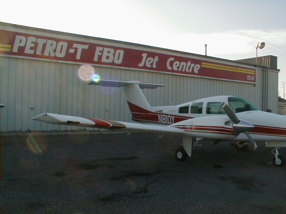
FBO at Quebec
I parked with the FBO, Petro-T and on close down I called the weather station at Quebec City so I could get clearance to make progress further north. The outlook was what I had been dreading; a major low pressure system was dominating the Hudson Bay area. Although I could get up to northern Quebec tomorrow, the system would create an icing problem on the leg to Iqaluit in Baffin Island and there was also a low pressure system between Greenland and Iceland. I felt that I needed to study the weather in more detail with the forecaster and he invited me to the control tower to look at the information. It was a great help to sit next to him, study the weather maps and make my own assessment. I decided I would stay in Quebec City until Tuesday and fly further north then. I had promised myself (and my wife) to take all reasonable precautions; I carefully put the Duchess to bed and prepared for my unscheduled break in this quaint and beautiful capital city.
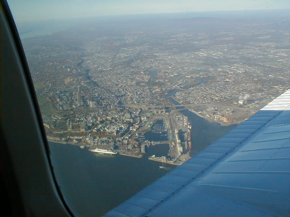
Departing Quebec
Tuesday 14 Oct
I had been very fortunate to see Quebec City in the autumn; the colours were just fantastic and the weather had been beautiful. I had taken the opportunity to stock up with survival food (bars of cookies and chocolate, as well as 6 litres of water) in case I had to force land in a remote spot. I had also previously purchased a very good sleeping bag that could withstand extreme temperatures, other warm clothing and an essential leatherman tool that had already proved invaluable; it could even be my last line of defence against polar bears!
But I was now pleased to get on my way again, particularly in such pleasant weather. I had lovely views over the City and the Lawrence estuary on departure to Shefferville in Labrador. Canadian ATC were adamant that I should detour round a military training area to the north, adding some 50 miles to the leg; following the airways seems to be the norm in these parts – probably something to do with being easier to find you if you don’t make it! I settled down to the leg and on my turn inland had to penetrate cloud. I immediately picked up ice and asked for permission to descend. A minute later, still waiting for permission to descend, the ice was becoming more interesting on the wings, so I told ATC I was descending which they agreed without delay. I broke out below cloud to see the most impressive barren scenery one could imagine; nothing for hundreds of miles around. I was getting limited VHF radio rebroadcast communication and my first experience of being totally on my own. 3 hours later I approached Wabush airfield and they confirmed they had fuel so I decided for an early stop with them. A further reason was that Shefferville airport, 1 hour further on only had fuel in 45 gallon drums which required me to purchase the whole drum; I needed one and a half drums (not good economics) and I was uncomfortable about drum contamination risk.
So I had a very welcome break in Wabush Labrador, refuel, a quick lunch and onward to Kuujjuak in northern Quebec. I noticed again how different the accents are here, and how close they seemed to those from the west of Ireland from where many of the Newfoundlanders had been settled. This final 2.5 hour leg was again enjoyable, mostly VFR between layers of cloud, with plenty of opportunity to admire the totally barren scenery – lakes, rivers rarely touched by human contact. A hole in the clouds allowed me to descend free from ice and Kuujjuak appeared finally; a small 2000 strong hunting and fishing settlement in the most remote and picturesque area one could imagine. The sun was setting as I landed making the landing on the westerly runway quite a challenge. The refueller told me that caribou often roam the area and swim the nearby lake during their migrations. The Ninuit (eskimo in European parlance) make a living here now supporting US hunting trips and the irregular tourist trade.
Wednesday 15 Oct
I had been told by the weather forecaster in Quebec City the night before that the weather in Iqaluit, Baffin Island, 340 nm further north would not clear until later in the day. I checked with them again in the morning to be told that a major low pressure system was moving that might prevent me getting there for days. I was dismayed; I decided then to speak to the forecaster at Sondestrom in Greenland and got a slightly different picture – yes, the weather would deteriorate in Baffin Island but not until tomorrow morning and it should be OK for getting there today. There is no doubt that the Sondestrom forecasters have a good feel for the weather in these parts. My deliberations had delayed my departure from Kuujjuak until 10 am with the actual at Iqaluit now reporting clear conditions. I was somewhat irked that I had missed an earlier departure since my plan was to get to Sondestrom in Greenland today via Iqaluit. I wriggled into my immersion suit and donned my aircrew life jacket for the first time since this was the first serious sea crossing of the trip. I also placed my liferaft on the seat next to me, securely strapped in by the seatbelts for ease of access in emergency. I also had a grab bag within easy reach which contained other survival essentials.
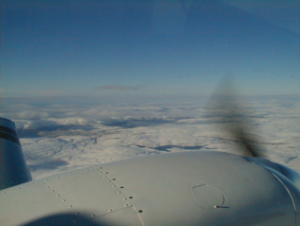
Greenland Coast
This leg took me straight over the sea to Baffin Island and I started to see my first icebergs before long. What a desolate area, reassured occasionally by communication from high level traffic. I was not expected to contact Iqaluit until 40 miles before arrival – a long time on my own in these parts! Coasting in over Baffin Island, one could immediately notice the change in landscape – higher snow covered mountains without a sign of a sole. Iqaluit were reporting almost clear conditions and I was relieved to descend VFR, and stay out of the cloud covered hills surrounding the airport since I knew I would pick up ice if forced to use their precision approach in IMC.
Iqaluit is very picturesque and a more developed settlement than Kuujjuak, with about 5000 people, again mainly employed in hunting and shooting. I wanted to have a quick turnround and get on my way to Sondestrom but the controller told me that Sondestrom shut in 2 hours time and they would charge $1000 to stay open. I resigned myself to staying here for the night, refuelled, and arranged for tanis (electrical heating) of the Duchess engines since I was concerned that cold soak during the freezing night would result in early morning starting problems. This would cost a mere non-negotiable $75 but worth it if it got me on my way home.
The Navigator Inn here is very friendly and comfortable; I did a time appreciation for the following day to get through Greenland and reach Iceland before the Danish airports closed. This would require me to depart Iqaluit 1 hour before sunrise at 7am. This would be a 3 leg, 1250nm stretch via Sondestrom and Kulusuk airports, so I settled for an early night once I had confirmed again with the Sondestrom forecaster that the weather would be suitable tomorrow.
Thursday 16 Oct
I was up at 5.30 this morning checking the latest weather with the forecaster in Sondestrom again. There was a big low pressure system descending on Baffin Island that would arrive in Iqaluit in the next hour and remain for several days. After passing the Baffin coast outbound, I would be entering high pressure on my way to Sondestrom and good weather was also promised over the Greenland ice cap with some weather likely to influence my arrival in Reykavik. The freezing level there would be 6000’ approximately so I was not too concerned on this sea passage leg.
I was relieved that the engines started on cue since it was just below freezing in Iqaluit – perhaps that $75 overnight heat soak was worth it after all. On departure at 7am the dark sky was still slightly moonlit showing layers of cloud that I could fly between. I knew that I could easily climb on top if necessary and avoid icing. The snow covered hills on climb out reflected the natural light and with night vision perfected, the landscape seemed even more remote than before and rather eerie. 50 miles later I was coasting out and able to see again the many icebergs that gathered in this area. The cloud now cleared as predicted and blue sky appeared with the sunrise. It was comforting to still get VHF radio communication with Arctic radio, presumably from a remote broadcast outlet in the area and also to keep in touch with the occasion airliner overhead.
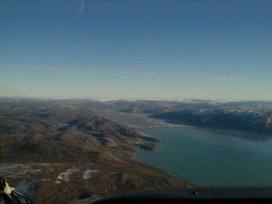
Approach to Sondestrom
The remainder of the trip was plain sailing; Sondestrom Approach took control at the FIR boundary. On approach I got my first view of the splendid fjords on the west coast of Greenland. They were quite spectacular, draped in snow with the ice cap in the background; it was difficult to concentrate on my approach to Sondestrom Airport with such a distracting view. Again, I was met by friendly ground staff, interested in where I was going, although customs did not seem interested in the slightest. These refueling stops are often opportunities for meeting other ferry pilots. I had the amazing coincidence of meeting a pilot here who lives only 4 miles from my new home in England. He was flying a Cessna 340 onwards to Iqaluit and the poor weather – good luck to him!. We swapped addresses and remarked what a small world it is.
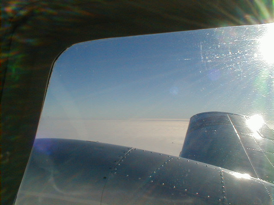
Over the Greenland Icecap
I did not have sufficient fuel reserves to get all the way to Reykavik so I departed for Kulusuk on the east coast of Greenland. The ice cap is over 9000’ high in this region so I climbed to 12000’. The weather was perfect; clear blue sky and a fantastic view of the glacier formations. Hundreds of miles of desolation, except for a research post in the centre which I overflew. Again on my descent to Kulusuk, I was treated to the most memorable views of the fjords, this time with the sea in the background cluttered with icebergs. This narrow runway (hardpacked cinders) has a few houses scattered in the area and is used for hunting and fishing. The approach has to be carefully watched if the weather is marginal – I can assure you it needs careful watching even when the weather is perfect!
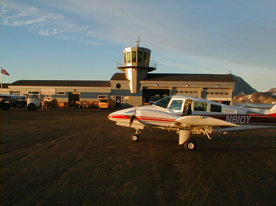
Refuel at Kulusuk
I had arrived 30 minutes before the airport closed – hence my early departure this morning from Iqaluit. This place proved to be my favourite location; it truly is the most remote and beautiful location I could imagine. It seems that polar bears occasionally stray into the airport – clutching my trusty leatherman, I made my departure for Reykjvik!
I had a further 400 nm on this last leg and as the sun was setting I was feeling that I was making significant progress. The sunsets in these latitudes are spectacular and I saw the most memorable one this evening. I kept making turns left and right to catch views of the setting sun behind me disappearing beneath the ice cap.
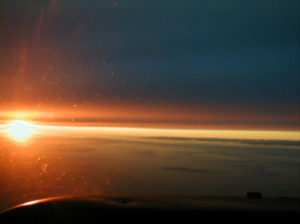
Sunset Over Greenland
Gradually it went dark and the weather deteriorated as predicted; total blackness and flying in cloud hundreds of miles from anyone. I was at 7000’ and my digital outside air temperature gauge showed that it was hovering on freezing. I kept checking for ice on the wings using my flashlight and noticed that I was getting some buildup – so I told Iceland control that I would like to descend to 5000 and they obliged. The temperature at this altitude was a reassuring +4 Celsius so I sat back, relaxed and contemplated the final approach to Reykavik. I finally saw the approach lights at 1000’ and taxied into the FBO who yet again were extremely helpful and had even organized my hotel room with a view of the Duchess parked on the airport apron! Altogether 10 hours flying today from Baffin Island and I now felt I was almost home; I would sleep well tonight. How did Lindenburgh manage 33 hours without a break, no autopilot or GPS I wondered.
Friday 17 Oct
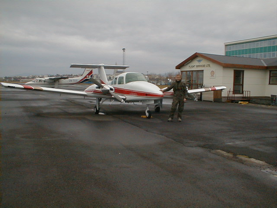
Departing Reykjavik
It doesn’t get properly light here at this time of year until mid morning, and feeling tired from the previous day, I didn’t get airborne until 11 am. I had been very impressed with the FBO at the airport; very efficient and everything one needed without even asking. The sea crossing to Stornoway from Reykjavik is nearly 600 nm. With a headwind, this would be a challenge for the Duchess and I had no wish for an unscheduled diversion to the Faroes. The weather promised to be good on the way south with light headwinds but when I broke out on top of cloud at 7000’ I noted 30 kts wind on the nose; it was a simple decision to divert to Hofnafjordur (BIHN) on the southern tip of Iceland, cutting some 70 miles off the journey. The diversion also gave me a fantastic view of the beautiful Icelandic landscape – icefields and magnificent mountains and fjords. BIHN had been weathered in for several days and I was the first aircraft they had seen for a while. This is a very rugged, natural area that would be well worth a trip from Scotland in the future.
I quickly got on my way to Stornoway after topping off the tanks. Levelling out at 8000’ I zoomed out on the GPS map and could see the familiar coastline of Scotland; 3.5 hours to go. It seemed strange to hear the familiar Scottish ATC accents speaking to me in N810Y – I was almost there! The weather was beautiful and Stornoway looked idyllic in the evening sun. I landed at 5 pm and cleared customs very pleased to have the journey behind me. I had forgotten to cancel IFR on my way inbound and was charged IFR approach fees of £20 by Stornoway; a reminder of the differences in our systems. It was great to be here pretty well on time and I thought then of spending the night in Northern Ireland with my parents. I filed for Belfast City and was on my way again within an hour. The sun was now setting over the Highlands and Islands on this short flight. I had flown regularly up here to Benbecula in previous years but never seen a sunset like this which I tried to capture on camera. It was dark when I touched down in Belfast City at 8 pm very glad to be with family after such a remarkable week.
Saturday 18 Oct
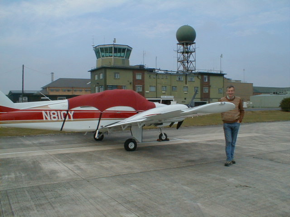
Back at Yeovilton
I had made arrangements to arrive at RNAS Yeovilton at 11 pm. They open periodically at the weekend so I wanted to take advantage of this slot. This would be only a 250nm leg; hardly worth putting the undercarriage away! Again I was blessed with clear conditions and I had splendid views of the Isle of Man and Wales on the way south. I had filed IFR which I cancelled and proceeded direct when the controller wanted to route me via Liverpool. The weather was cloudy further south and I got radar cover from Cardiff and Bristol as I neared Yeovilton. I broke cloud at about 1500 ft and landed just after 11 pm and pulled up to the control tower. What a trip it had been; 36.3 hours and the Duchess had performed impeccably. I had not needed to delve into my spares pack of 8 spark plugs and assorted light bulbs, screws and locking wire.
The trip had been an exercise in risk management – it proved the value of being prepared properly, with the right aircraft and having the necessary experience. I consider myself very lucky to have had the opportunity to experience this and to have seen the most memorable, spectacular scenery. It had been one of the flying highlights of my aviation career. SAFETY FIRST!
